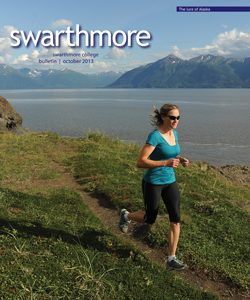North to Alaska
Lure of ‘the last frontier’ attracts an array of adventurous alumni
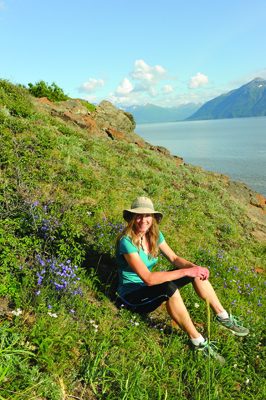
Laura Fox, originally from the Boston area, is grateful to have a professionally challenging job in such an outdoor-friendly place. “Anchorage is not a sprawling metropolitan area,” she says. “In 20 minutes, I can be hiking up in the Chugach Mountains. In Boston, you drive through suburb after suburb after suburb for hours.” Photo by Bob Hallinen
In spring 2008, Laura Fox ’03 had one immediate goal: hike the Pacific Crest Trail from Southern Californiaall the way to British Columbia.
As she was preparing to leave Yale Law School, she got a message from the career office. The chief justice of Alaska’s Supreme Court had a last-minute opening for a clerkship that fall.
Two days into her trip, from a campground along the trail, Laura did a phone interview. She got the job.
By late August, she had finished her 2,600-mile journey. After buying a set of work clothes, and arranging for her mom to send more, Laura headed north to Alaska to work for Chief Justice Dana Fabe.
Fabe was always on the lookout to keep talented newcomers in the state. “She said, ‘Oh, I can get this one to stay,’ ” Laura says. At the end of her clerkship, Fabe alerted her to an opening at the state’s law department.
Along the way, Laura made a friend who had a small airplane, perfectly suited for flying deep into the wild country where few Alaskans go. Laura found herself taking wilderness trips in the Brooks Range and the Wrangell Mountains, fishing for salmon, and smoking the fish she caught.
Lured to Alaska, she was hooked.
Open to Adventure
In contrast, the path that led Terry ’66 and Mimi Carroll Chapin ’66 to Alaska “goes back to Swarthmore,” Terry says.
He had taken a seminar on the relatively new field of ecology, and it became his passion, with a focus on the Arctic. After graduate school, the only job he could get was at the University of Alaska in Fairbanks.
He and Mimi both had been in Swarthmore’s Outing Club, so they were open to a northern adventure. But they didn’t really know what they were getting into. Mimi laughs, recalling how Terry showed up in Fairbanks in July, wearing long johns and woolens, when the temperature was approaching 100 degrees.
In the early days of his field studies in the wilderness, he arranged for Mimi to come along as camp cook. He was well on his way to becoming an international expert in Arctic ecology and the first Alaskan elected to the National Academy of Sciences.
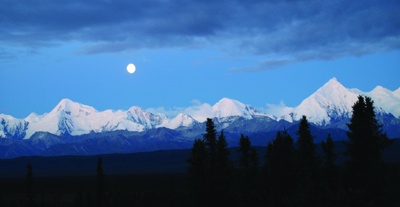
The night moon peeks out over Denali, the highest mountain peak in North America. Photo by Matt Zencey ’79
After they had kids and settled down, Mimi’s Russian studies background proved useful when the “ice curtain” separating Alaska and the Soviet Union began to thaw, and scientists and visitors began going back and forth. She taught for a while in Russia, translated scientific papers, and helped set up cultural exchanges, like the sister-city relationship between Fairbanks and Yakutsk.
Northern Exposure
The Chapins lived in Fairbanks, which to those of us living in the relatively mild location of Anchorage, was an inhospitable Arctic outpost with brutally cold winters and far fewer civilized amenities. If my first exposure to Alaska had been frigid Fairbanks, I might not have stayed.
I arrived in Anchorage in 1980, as a volunteer with VISTA, the domestic equivalent of the Peace Corps. That year with VISTA turned into 30 satisfying years in nonprofit work and journalism. I finished my Alaska career in 2010, as editorial page editor of the Anchorage Daily News, a paper that twice won the Pulitzer Prize for public service.
During those three decades, I repeatedly encountered Swarthmore alums who occupied prominent positions in Alaska life.
Their ranks included a colleague at the newspaper, the state’s director of insurance, a judge who was runner-up for a state Supreme Court vacancy, an attorney for the Alaska Civil Liberties Union, a member of the Anchorage School Board, the minister of the state’s largest Unitarian Universalist church, and the woman who ran a land trust that preserved my favorite natural spot in Anchorage.
Lohr is Lured
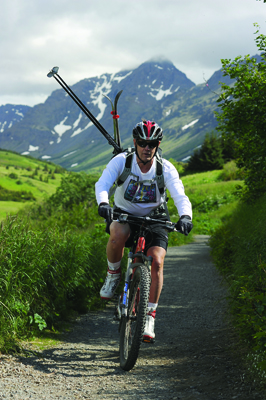
Bob Lohr ’70, veteran of many wilderness adventures, says he has experienced things “Alaskans had no idea about.” Facing page: A view of Turnagain Arm, from Alyeska ski resort, Girdwood, Alaska. Photo by Bob Hallinen
One of the first people I met in Alaska was Bob Lohr ’70. He’d come to Alaska in 1974, also with VISTA. After four years of working in business, he says, “I realized the social conscience learned at Swarthmore was being neglected.”
He landed in the town of Tok, about 90 miles past the Canadian border on the Alaska highway. Tok is a speck of human settlement amid vast wilderness, with winter temperatures of minus 70.
Bob helped launch an economic-development agency serving the impoverished Native peoples of the rural area. During his five years out there, Bob also drove an ambulance and trained to be an EMT. He once had to do CPR on a stabbing victim on board a tiny Cessna 206 airplane, as the pilot desperately tried to reach the nearest doctor.
Along the way, Bob made a lifelong friendship with Chief Andrew Isaac, traditional leader of all Athabaskan Indians in that part of Alaska. Their ties were so strong, when the chief died, Bob was given a Winchester rifle at the funeral potlatch—“the ultimate sign of respect,” Bob says. As a further honor, Bob was the only non-Native to help dig the chief’s grave.
Bob went on to become director of the Rural Alaska Community Action Program, a statewide anti-poverty agency; executive director of the state public-utilities commission; and state insurance commissioner.
It’s probably Bob’s fault I got hooked on Alaska. After my VISTA year, he hired this fellow Swarthmorean at his anti-poverty agency. (He might have felt guilty after my attempt to try out his hang glider landed me in the emergency room with a broken nose.)
For the first time after graduating, I was making decent money and having great adventures. I was getting paid to travel to a dozen remote, isolated Native-American villages, and help residents cope with painfully high energy costs.
Then the state started paying me to live there. In 1982, Alaska started its innovative wealth-sharing program that pays every resident—man, woman, and child—a “dividend” from all the extra oil money that pours into the state treasury. I’d probably have stayed anyway, but getting a $1,000 check that year, with the promise of more, certainly helped.
Eyed by Palin
Eric Smith ’75 also got a big boost by connecting with Bob. In the 1980s, Eric ran a nonprofit environmental law firm, Trustees for Alaska.
For several years, the group worked on disputes that repeatedly made headlines. They helped protect Native villages from a type of gold mining that used bulldozers to churn up nearby streams and won a battle to protect the world’s largest wild salmon fishery, Bristol Bay, from oil drilling.
But being an environmentalist in Alaska is like being an animal-rights activist in Texas cattle country. Tired of fundraising, and knowing Alaska’s environmentalists needed to build coalitions with other, stronger, Alaska forces, Eric shifted to working on Native legal issues.
Enter Bob Lohr. His anti-poverty agency hired Eric to work with Alaska Natives on causes like protecting their hunting and fishing rights and seeking greater self-government powers as allowed under federal Indian law.
Eric’s years of work were so well-regarded, the Alaska Federation of Natives gave him its highest accolade for work by a non-Native, the Denali Award.
Support from the politically influential Native movement helped Eric land a judicial appointment to a state superior court in Palmer, a small town about 40 miles north of Anchorage.
Eric lives in a rural mountain valley, officially part of Anchorage but just a short hop away from Alaska’s wilderness.
“We’ve had bears in our backyard,” Eric says. “We’ve had coyotes in our backyard. We’ve had moose in our backyard. We had a bear dig out a septic pipe. We kept a cap [from the pipe] with the bear’s teeth marks in it.”
When a seat on Alaska’s Supreme Court opened up, Eric applied through the state’s merit selection process. One of two finalists, he got an interview with the person who would make the final choice, Alaska’s governor—Sarah Palin.
Palin, notorious for multitasking during meetings, “never looked at her Blackberry the whole time. I took that as a good sign,” Eric says. But he had spent his early career working for environmental groups and Native interests, two forces that often opposed Palin’s agenda, and she picked the other candidate.
The Great Outdoors
If you’re going to live in Alaska, it helps to love outdoor adventures. It’d be tough to match Bob Lohr on that front.
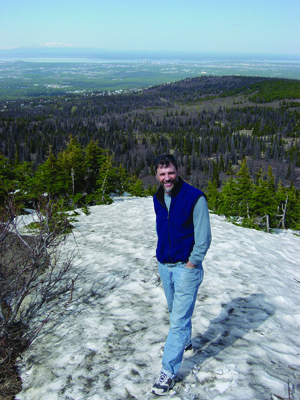
Snowfall in May isn’t rare for Alaska, Matt Zencey ‘79 discovered. Photo by Cindy Zencey
I considered myself reasonably adventurous—I’ve been up close with salmon-eating bears in Katmai National Park, and I’ve hiked in the Brooks Range, 100 miles from the nearest outpost of humanity. But compared to Bob, I’m a couch potato.
Twice he climbed Mt. McKinley, also known as Denali, the continent’s highest peak. Felled by altitude sickness and evacuated by helicopter the first time, he returned the next year and made the summit.
Several times, Bob ran the Hope to Homer race, 150 miles across the wilderness. He did the Iditaski, a 120-mile winter ski race covering part of the famed Iditarod Trail.
For fun, he did a cross-country ski trip by himself along the same trail, some 350 miles to the isolated interior mining town of McGrath, with two dogs to keep him company and occasionally help pull him along.
“It was some of the most incomparable scenery anywhere,” Bob says. With about 100 miles to go, he broke a ski and had to do an emergency repair. “It didn’t affect the sliding of the ski that much,” he says with pride.
Bob once lured me on a winter camping trip. With three of us and a dog in a small tent and temperatures of 30 below, I slept wearing every bit of warm clothing I had, including a parka rated to 40 below. I was barely warm enough. Bob is the kind of Alaskan who gets a fat-tire mountain bike for his 65th birthday, so he can more easily keep riding through the snow in winter.
Eric Smith is an adventurer, too. For his honeymoon, he took his wife on a river trip through prime caribou-watching wilderness in the Arctic National Wildlife Refuge.
Breaking to the ‘Outside’
People in the Lower 48 often ask Alaskans two questions: Why did you go there, and why did you stay?
“The romance of being in Alaska drew us here,” says Mimi Chapin. “What kept us here was the excellent school system. The schools were as good as the private schools I went to on the East Coast.” Thanks to the oil boom that started in the 1970s, schools had plenty of money and could attract young, motivated teachers.
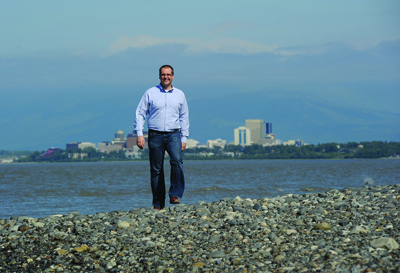
Tom Stenson ’00 says, “ In Alaska there’s a sense that everybody’s in this together. If your car is in the ditch, you’re going to need help getting out, and when you get help, you’re not going to care what ethnicity he is.” Photo by Bob Hallinen
But there came a time, Mimi says, when those long winters, in their house on a dark, cold, north-facing slope, became an issue. Despite staying busy—getting outside every day no matter how cold it was, playing music, or learning to carve ice sculptures with a chain saw—they were ready for a break.
“We kind of wanted to check out other parts of the world,” Terry says. “Fairbanks can be a little insular.”
Terry took a job teaching at UC–Berkeley in 1989 though he would return for summer field work. That strikes many an Alaskan as a dream scenario—winters Outside (as Alaskans call the world beyond state borders), summers in Alaska—but after nine years, they came back, this time to a house in a brighter, south-facing location.
The long, dark winters were an issue for me, too. I definitely had seasonal affective disorder. I arranged for our family to spend two winters Outside, one at Harvard, the other working at a nonprofit job in Washington, D.C., exposing my kids to a wider, more civilized world and thawing out my brain. I came back with a renewed appreciation of Alaska’s natural wonders and wide-open spaces.
When I talked to Tom Stenson ’00, in mid-May, he was more than ready for winter to end. After six months of steady snowstorms, including a recent one, it was finally safe to get the snow tires off his car.
At least Tom had known what he was getting into—his first exposure to Alaska was in February.
“Everyone who’s thinking of moving to Alaska should definitely come in February,” he says, with a chuckle. It was around the time of Fur Rondy, Anchorage’s big winter festival. “People were very friendly, very open”—a common theme in Alaska. The state has barely more than one inhabitant per square mile, so you can’t be too stuck-up.
Tom is one of those lucky Alaskans who followed a spouse northward and managed to land a professionally rewarding job.
Anchorage, he says, “was kind of what we’d been looking for,” away from the bustle of the East Coast, close to the outdoors, but “still a city, with all the creature comforts … very approachable, not overwhelming, easy to navigate—no traffic jams.”
Two weeks after he arrived, the American Civil Liberties Union hired him. Tom worked on prison reform, then on a wider range of issues.
One case required him to tromp through the woods and frozen bogs of Anchorage in winter, looking for homeless people in their camps, trying to follow foot tracks in the snow. He remembers thinking, “What have I gotten myself in to?” (At least it was winter. The bears were hibernating.)
Like many of us, Tom sees Alaska as a place where it’s relatively easy to make a difference.
“There’s definitely a big fish/small pond effect here,” he says. “I can testify in front of the legislature, and the legislature cares what I have to say.”
Pull of the Lower 48
A Swarthmorean who came north for part of her career then left was Beth Silverberg Burger ’89.
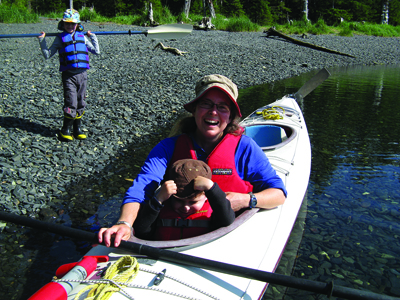
Beth Silverberg Burger ’89 and her family enjoyed the natural wonders of Alaska before moving back to the Lower 48. Photo courtesy of Beth silverberg Burger ’89
After a few years practicing law at a big New York City firm, she landed a post at the Great Land Trust in Anchorage. I met her when the trust was working on a deal to protect Fish Creek estuary, a quiet oasis along the popular trail that graces Anchorage’s coastline.
Beth speaks fondly of Alaska adventures—dip netting for salmon on the Kenai River in water up to her chest, elbow-to-elbow with scores of other fishermen, waiting to feel the thump of a fish hitting the net at the end of her pole, or floating on a river through the Arctic National Wildlife Refuge and seeing thousands of caribou surge across the landscape.
She lived on a hillside near Anchorage, with a grand view across the waters of Knik Arm to Mt. McKinley, more than 100 miles away.
But being married with a couple of young boys, she felt a strong pull toward family in the Lower 48, especially with her father having health issues. Their mountain idyll was a long drive from a good school, and she wanted to expose her kids to a more intellectually and culturally stimulating place. Her recent move to Ithaca, N.Y., came at a good time, as she soon needed to help her parents through health crises.
Upon learning of a death in the family, many an Alaskan has had to scramble for an empty airline seat and a bereavement fare to a distant city, as I did when my father died.
Swarthmoreans Aplenty
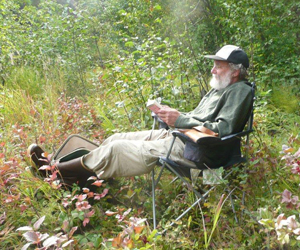
Eric Smith enjoys some reading in the Alaska wilderness.
Though I kept running into Swarthmoreans, there wasn’t exactly a Quaker cabal in Alaska. No secret Garnet
Still, Swarthmoreans kept popping up in my Alaska life. In the late 1990s, when the stress of work was getting to me, my doctor referred me to a psychiatrist, Ron Feigin ’67. If I had ever needed to declare bankruptcy, I could have called on Cabot Christianson ’75, whom I met when he served on the Anchorage School Board in the early 1990s.
Today, Swarthmore’s online directory lists 46 Alaska residents, including current students. Most are in Anchorage or Fairbanks, but a few wandered off to smaller locales—Juneau, Soldotna, Valdez, and even Denali Park.
Though I was surprised to find so many Swarthmoreans in Alaska, it does make sense. The state draws people with the same curiosity and desire to make a difference that Swarthmore seeks and nurtures.
“There’s a magic to Alaska, an allure that draws people there … a promise of something bigger than yourself,” says Beth Burger.
“Alaska is full of civic-minded people. You can have a lot of impact without a lot of resources, with just sheer will. … Innovative things can be done relatively easily.” And, she says, compared to high-pressure locations like New York City, “It’s easier to have a balance in life.”
Others, like Bob Lohr, never felt a pull to leave. Any time he headed Outside, he says, “It would disabuse me from wanting to move back.”
A Return to Roots
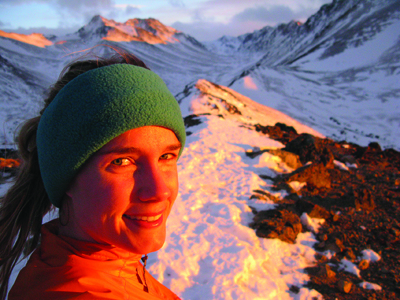
Laura Fox ’03 in the Chugach Mountains, the part of Chugach State Park that is directly behind Anchorage. Photo by Laura Fox
My time in Alaska came to an end in 2010. The Anchorage Daily News was slashing staff, my youngest son had just left for college, and for five years, I’d had a commuter marriage with my high-school sweetheart, an accomplished professional and wonderfully big-hearted winterphobe who was definitely not going to uproot her life and move to Alaska.
Ready as I was to return closer to my roots, in a warmer, more civilized part of the world, my leaving was bittersweet.
Twice in my career, I got paid to go on luxury eco-cruises through southeast Alaska’s coastal rainforest, gawking at 200-foot trees and snow-capped mountains while hosting dignitaries, including four members of Congress. I traveled on a Coast Guard plane flying right past the summit of Mt. McKinley, all 20,000 feet of it in cloudless glory.
I got to hike through the tundra wilderness in Gates of the Arctic National Park and Preserve, on a trip when a bear ate almost all our food. I gazed at the 100-foot layer of ash left behind by the largest volcanic eruption recorded in North America. I wandered through rusting, crumbling relics of World War II military sites in the Aleutian Islands, 1,000 miles from my home.
Alaska provided me adventure and a rewarding professional career. Anchorage was an ideal spot for me to raise my two sons, with strong public schools, great parks and trails, easy access to wilderness right behind town, and a strong sense of community.
The Chapins remain contented Alaskans. As we chatted by phone shortly before summer solstice, when daylight lasts well past midnight, Terry told me, “It’s 6 p.m., and we’re sitting on our porch. We can’t see another house. We can’t hear anything but the leaves and the wind.”
Likewise satisfied, Eric Smith says of himself and his wife, “We’ve made a very good life. There’s no way I could have done what I did anywhere else.”
Matt Zencey ’79 graduated with highest honors in economics. He is the author of Unlikely Liberal: Sarah Palin’s Curious Record as Alaska’s Governor. Zencey is deputy opinion editor of PennLive and The Patriot-News in Harrisburg, Pa.
 Email This Page
Email This Page